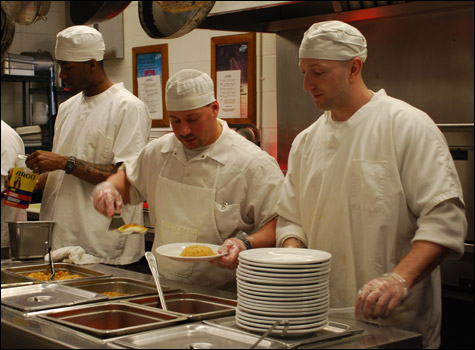
HARD-BOILED: Prisoners prepare for life outside of jail by preparing three-course meals for civilians — for less than a buck-fifty. |
Unfortunately, getting out of prison doesn’t necessarily mark an end to a life of crime. A study released this past week by the Urban Institute and the state’s Department of Correction found that one in 10 Massachusetts prison inmates freed in 2002 returned to prison within three years. This number may seem high, but compared with the national average of 53 percent, it appears the state’s correction agency is doing something correct. One of those things might be an unusual job-training program that allows inmates to serve the public while they serve their sentences.
The 200-acre Northeastern Correctional Center (NECC) feels so pastoral that prisoners refer to it as “Concord Farm.” The fences at this minimum-security prison on Route 2 are there primarily to keep in the facility’s 80 cattle, not its 266 inmates (who are, nevertheless expected to stay close). There are no guard towers or high brick walls like the ones surrounding the medium-security prison across the road (MCI Concord), and an open gate welcomes cars to follow a rustic dirt path to the campus’s center. Five days a week, between 11:30 am and 12:30 pm, parades of drivers make the trip for a unique opportunity: a three-course meal prepared and served by inmates.

The 10 tables — four place settings each, set with metal forks and spoons but plastic knives — at the Fife and Drum restaurant are filled to capacity every day. Perhaps it’s the ample parking or the rare chance for a cell-phone-free meal — security confiscates all electronics when you enter the prison — but chances are it’s the price that keeps people coming back. After all, a filling meal here costs only $1.42 ($1.35 for the meal plus seven cents tax). This is the only culinary-arts prison program in the United States that opens its doors to the public, and it functions just like any other restaurant (and who’s to say normal restaurants aren’t filled with convicts, anyway?).
The program, created in 1983, is not just a spot for intrepid and frugal diners, but it is often the last stop for inmates on a long journey out of prison. When prisoners are convicted, their placement in prison (whether it be a minimum, medium, or maximum facility) is based on a points system. Depending on the crime and behavior, inmates gain or lose points and can be transferred to various sites. In this game of penitentiary golf, a low score will eventually lead you to a facility like NECC, where about 90 percent of inmates are released within four years.
Paul Ruane, the superintendent of NECC, believes that initiatives similar to the Fife project can help keep the state’s recidivism rate relatively low.
Participants in the program, says Ruane, leave prison with “a certificate in their hands, and now they don’t have to start their job as a dishwasher in the real world making just eight bucks an hour. They can usually start mid-level. If you have a good-paying job, you are now least likely to re-offend.”
No fear
The dining room at Fife has the sterile feel of an upscale hospital cafeteria with a dark side, as if Nurse Ratched would take her lunch break here. Uniformed correctional officers chat with white-clad and tattooed servers, while diners, many senior citizens on fixed incomes, scour the menu. A sign on the dining-room wall reads: “Never trust a skinny cook.” Instead, diners are expected to put their trust in some beefy prisoners, as though risking life and limb with each request for a starter salad. Regular customers seem to get over that; a frail-looking elderly woman doesn’t hesitate to remind her server — who, for all she knows, could be finishing up a murder sentence — that she’s still waiting for a glass of water.
To order, patrons write down what they want on little pieces of paper, and this being Friday, everyone’s ordering fish — creamy, peppery clam chowder, followed by cod baked in savory garlic breadcrumbs. Clearly, this is not your typical prison gruel (dessert is molten chocolate cake). No one even bothers probing their dishes for ground glass.
Regular customer John Gates, 66, has been coming to the Fife nearly every day it’s been open for the past 15 years.
“I was a little leery walking in the first day,” he says. “I didn’t know what to expect, or even if I was allowed to be here. But 15 years later, I know that I am, and that the food is good, and that the inmates are nice. I even bring my grandson sometimes.”
Soft cell
Given that the Fife caters to both members of the AARP and the local preschool, it can be a difficult place for inmates to get used to.
“It’s kind of uncomfortable dealing with civilians after being in for a while,” says Scott King, one of the kitchen’s three cooks. “But it’s definitely good to try. At first, being around people on the outside made me really nervous, but I know that I’m going to have to deal with them eventually.”